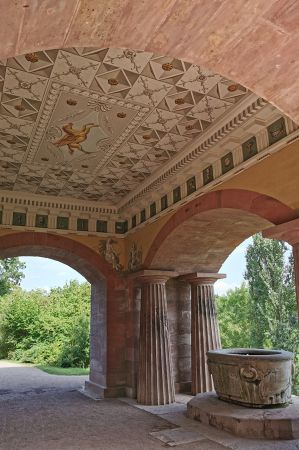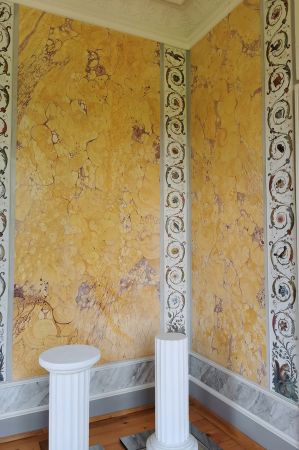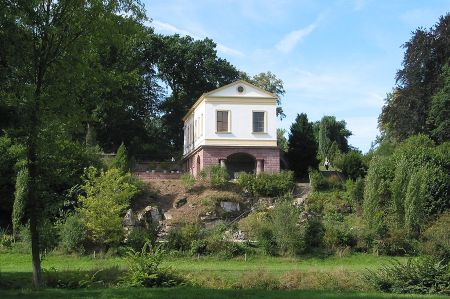Roman house in the park on the Ilm in Weimar
- Written by Portal Editor
Not that anyone thinks that the ancient Romans discovered Weimar or even founded it, but the "Roman House", a building on the edge of the park on the Ilm in Weimar, is always worth a visit.
Not only because it has been a UNESCO World Heritage Site since 1998 as part of the "Classical Weimar" ensemble.
The poet Johann Wolfgang von Goethe accompanied construction work
 The Roman House was built between 1791 and 1798 as a garden house for the then Duke Carl August and is considered one of the early neoclassical buildings in Germany. Located in the park on the Ilm, the house was once the favourite residence and retreat of Duke Carl August of Saxe-Weimar and Eisenach. It was the first classicist building in Weimar at the time, and at the beginning of the construction work the poet Johann Wolfgang von Goethe accompanied the work on the temple-like building in the Doric style. The building gives the impression that it was built on the ruins of an ancient building. The Roman House, inspired by the villas in the area surrounding Rome, is regarded as a classicist »model house« of Goethe's theoretical architectural considerations against the background of his trip to Italy.
The Roman House was built between 1791 and 1798 as a garden house for the then Duke Carl August and is considered one of the early neoclassical buildings in Germany. Located in the park on the Ilm, the house was once the favourite residence and retreat of Duke Carl August of Saxe-Weimar and Eisenach. It was the first classicist building in Weimar at the time, and at the beginning of the construction work the poet Johann Wolfgang von Goethe accompanied the work on the temple-like building in the Doric style. The building gives the impression that it was built on the ruins of an ancient building. The Roman House, inspired by the villas in the area surrounding Rome, is regarded as a classicist »model house« of Goethe's theoretical architectural considerations against the background of his trip to Italy.
It is therefore characteristic that it is based on a Roman temple. Goethe brought the inspiration for building the house in the Roman style back with him from his first trip to Italy. Due to its high location on the western long side of the "landscape park on the Ilm" it allows a wide overview of the north and south stretching Ilm valley.
 The architect Johann August Arens from Hamburg provided the architectural designs for the building. In the beginning, Goethe himself managed the building work. The drafts for the design of the interior came from the Dresden architect Christian Friedrich Schuricht. Johann Heinrich Meyer was also involved in the artistic design of the rooms. After Carl August's death in 1828, the garden house was rarely inhabited. From 1844 the house was left to Hereditary Grand Duke Carl Alexander. A drawing by Friedrich Gilly from 1797/98 shows the passage from the south below the Roman house with the Doric columns, the fountain that Martin Gottlieb Klauer probably created. Klauer not only created the wall decorations outside, but also those inside. The gable group of the west gable, which was originally created by him based on a design by Heinrich Meyer, was replaced in 1819 by one by Peter Kaufmann.
The architect Johann August Arens from Hamburg provided the architectural designs for the building. In the beginning, Goethe himself managed the building work. The drafts for the design of the interior came from the Dresden architect Christian Friedrich Schuricht. Johann Heinrich Meyer was also involved in the artistic design of the rooms. After Carl August's death in 1828, the garden house was rarely inhabited. From 1844 the house was left to Hereditary Grand Duke Carl Alexander. A drawing by Friedrich Gilly from 1797/98 shows the passage from the south below the Roman house with the Doric columns, the fountain that Martin Gottlieb Klauer probably created. Klauer not only created the wall decorations outside, but also those inside. The gable group of the west gable, which was originally created by him based on a design by Heinrich Meyer, was replaced in 1819 by one by Peter Kaufmann.
On the lower floor, an exhibition presents the development of the park
 In 1922, after the abdication of Hereditary Grand Duke Wilhelm Ernst (Saxony-Weimar-Eisenach) in 1918 as a result of the loss of the First World War, the Roman House became the property of the state of Thuringia. In 1954, the NFG took over the house, which had extensive renovation measures carried out on the building. Today it is used as a museum open to the public and houses a permanent exhibition on the history of Weimar's Ilm Park. Since 2012 there have been four torsos of the Templar figures from the Templar House, which Johann Peter Kaufmann created as copies of the wooden originals by Martin Gottlieb Klauer.
In 1922, after the abdication of Hereditary Grand Duke Wilhelm Ernst (Saxony-Weimar-Eisenach) in 1918 as a result of the loss of the First World War, the Roman House became the property of the state of Thuringia. In 1954, the NFG took over the house, which had extensive renovation measures carried out on the building. Today it is used as a museum open to the public and houses a permanent exhibition on the history of Weimar's Ilm Park. Since 2012 there have been four torsos of the Templar figures from the Templar House, which Johann Peter Kaufmann created as copies of the wooden originals by Martin Gottlieb Klauer.
You can visit the vestibule, which also served as a dining room, the Blue Salon, the scene of festive conviviality, and the Yellow Salon, the Duke's study. The adjoining rooms were used as bedrooms and dressing rooms. In the basement, an exhibition presents the development of the park on the Ilm since the late 18th century.
Please read as well:
Lystra and Isauria Vetus - places steeped in history
Rewa – Peninsula Reff, Fishing dock and the Amber Road
-
 Weimar- Roman House in Ilm Park
Weimar- Roman House in Ilm Park
Weimar- Roman House in Ilm Park
Weimar- Roman House in Ilm Park
-
 Weimar- Roman House in Ilm Park
Weimar- Roman House in Ilm Park
Weimar- Roman House in Ilm Park
Weimar- Roman House in Ilm Park
-
 Weimar- Roman House in Ilm Park
Weimar- Roman House in Ilm Park
Weimar- Roman House in Ilm Park
Weimar- Roman House in Ilm Park
-
 Weimar- Roman House in Ilm Park
Weimar- Roman House in Ilm Park
Weimar- Roman House in Ilm Park
Weimar- Roman House in Ilm Park
-
 Weimar- Roman House in Ilm Park
Weimar- Roman House in Ilm Park
Weimar- Roman House in Ilm Park
Weimar- Roman House in Ilm Park
-
 Weimar- Roman House in Ilm Park
Weimar- Roman House in Ilm Park
Weimar- Roman House in Ilm Park
Weimar- Roman House in Ilm Park
-
 Weimar- Roman House in Ilm Park
Weimar- Roman House in Ilm Park
Weimar- Roman House in Ilm Park
Weimar- Roman House in Ilm Park
-
 Weimar- Roman House in Ilm Park
Weimar- Roman House in Ilm Park
Weimar- Roman House in Ilm Park
Weimar- Roman House in Ilm Park
-
 Weimar- Roman House in Ilm Park
Weimar- Roman House in Ilm Park
Weimar- Roman House in Ilm Park
Weimar- Roman House in Ilm Park
https://www.alaturka.info/en/germany/thuringia/6258-roman-house-in-the-park-on-the-ilm-in-weimar#sigProIde026c94f78

